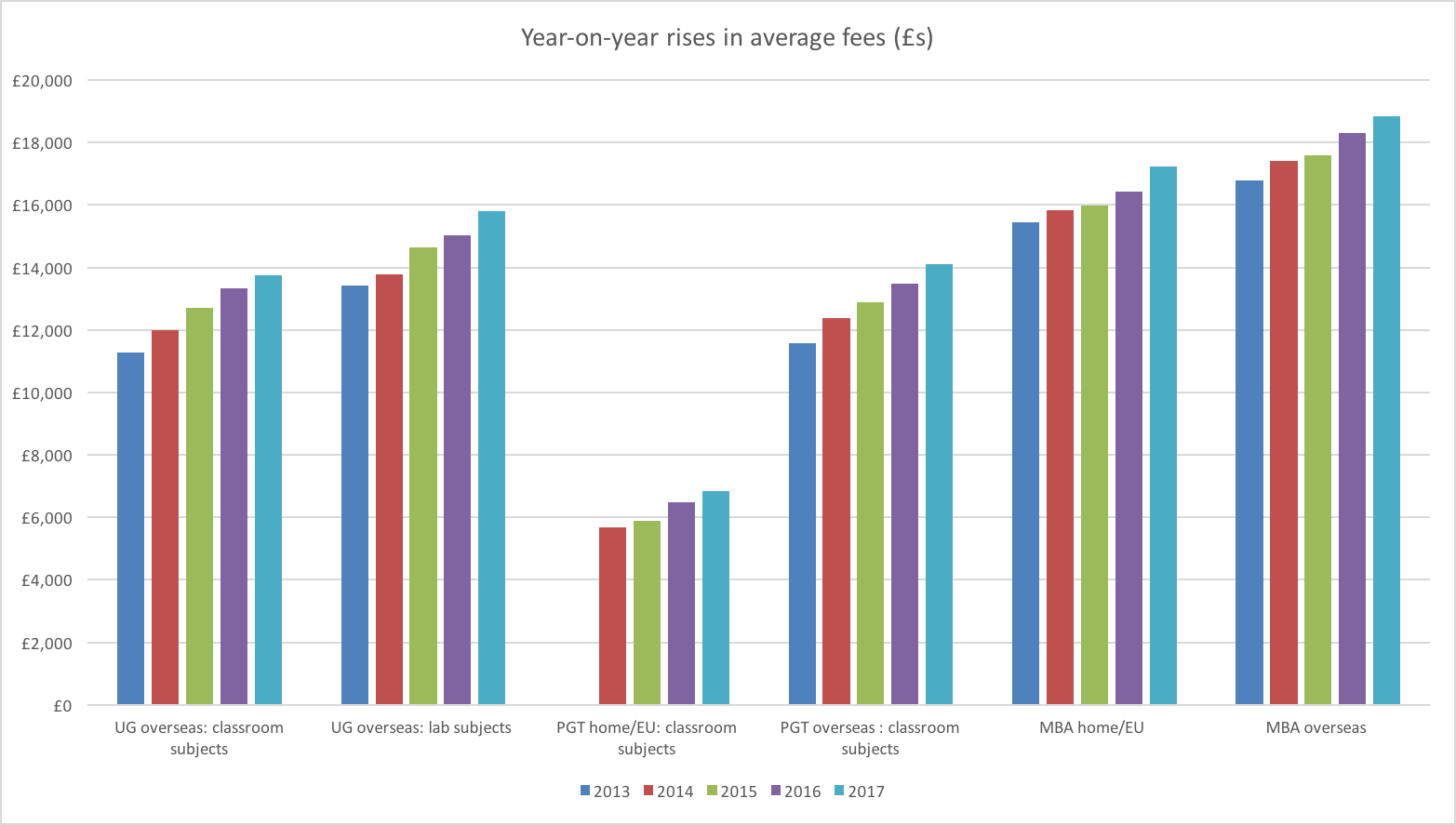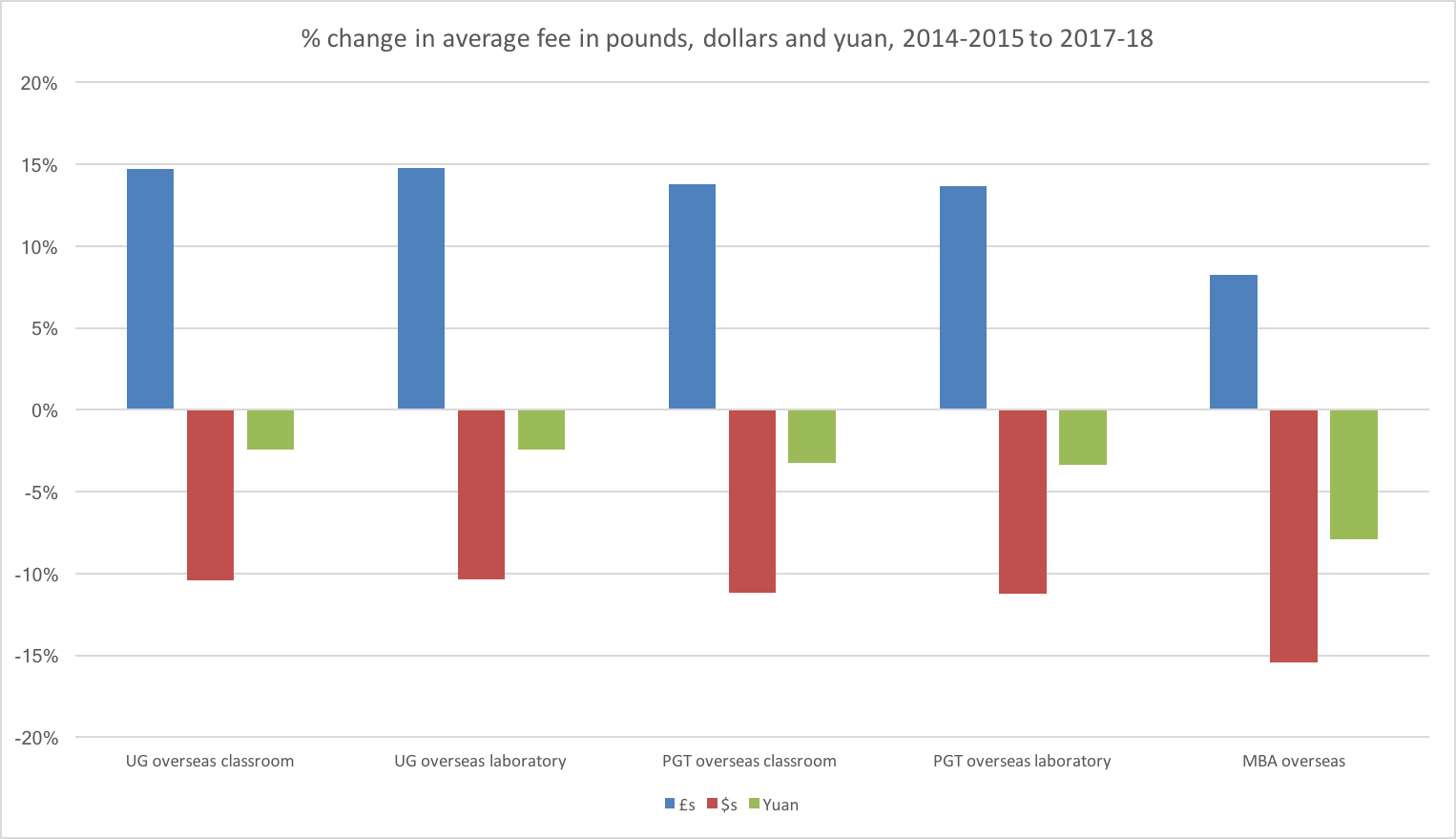Undergraduate tuition fees at English universities are firmly back on the political agenda, in large part because of Labour’s pledge at the general election to scrap them if it won power. The debate is also taking place as most undergraduates prepare for the first rise in fees since 2012-13, from £9,000 to £9,250.
But has the nudging up of the price ceiling for undergraduates from the UK and the European Union (who until Brexit still face the same charges) encouraged universities to increase fees elsewhere, such as for postgraduates and overseas students?
According to the latest annual survey of fees compiled by the Complete University Guide, charges for other types of courses and students have continued their upward curve. However, although the increases in average fees are generally higher than the 2.8 per cent uplift in the domestic undergraduate fee cap, the increases appear more restrained than they have been in recent years, especially for overseas students.
For instance, there has been a relatively modest 3.1 per cent increase for overseas undergraduates studying classroom-based subjects, taking the average up to £13,750, while the average cost of an MBA for overseas students has climbed by 3 per cent to £18,853.

Some of these average fees still represent a large gap compared with domestic students, but it appears that the gulf is not widening as quickly as it once was.
Alison Patterson, university liaison and research manager at the Complete University Guide, said that the “fairly flat picture” in some fee levels might reflect that universities are “mirroring the rest of the country – cautiously watching and waiting to see what is going to happen in relation to Brexit and making few changes as a result”.
Factoring in the fall in the value of the pound, which plummeted in the immediate wake of Britain’s vote to leave the EU in 2016, might suggest that the UK’s universities did not want to lose the competitive advantage they have gained against other destinations of choice for overseas students.
From 2014-15 to 2017-18, the average fee level for overseas undergraduates and postgraduates has risen in pounds by as much as 15 per cent. But the contemporaneous US dollar value of these fees reveals a different picture. For instance, the average fee level in dollars of a classroom-based master’s course was about $20,900 in 2014-15 (based on a July 2014 exchange rate), compared with about $18,600 for 2017-18, a drop of 11 per cent.
Of course, international students are not all converting their fees to dollars, and other currency exchange rates differ massively (and also depend on the exact time of the transaction). Nevertheless, making the same analysis of the currency used by those from UK universities’ biggest overseas student market – China – also reveals a downward, if more modest, trend (possibly reflecting the yuan’s fall against the dollar in recent times).

Note: Exchange rates taken at 31 July 2014 and 31 July 2017.
If universities are basing their fee decisions on exchange rates, fluctuations can come back to bite them if they put up charges too much, warned Nick Hillman, director of the Higher Education Policy Institute.
“Exchange rates can change rapidly, so universities also have to be careful that a sudden rise in the pound does not hamper demand in the future. Certainly some overseas students looking to study on longer courses may bear this in mind anyway when looking at fees,” he said.
Mr Hillman added that there was also a risk that the UK government would take a dim view of universities if they raised overseas fees when they had consistently impressed on ministers that demand from international students was very sensitive to government policies on immigration.
“There is a risk, I think, that if universities are putting up overseas fees, then the government may take that as a sign that they are not so worried about damaging demand from outside the EU,” he said.
Meanwhile, Rosemary Deem, vice-principal (education) at Royal Holloway, University of London and chair of the UK Council for Graduate Education, said that universities had a tricky balancing act on fee levels for overseas students, given that current EU students might face them in the post-Brexit future.
Professor Deem said that EU students were less likely to want to pay “the large fees that international students are charged [in the UK] because they can do lots of master’s courses in Europe either much more cheaply or free”.
She warned that the result after Brexit could be that universities cut back courses that attract a lot of EU students, such as modern languages, an area already facing pressure, rather than lower international fees to compensate.
simon.baker@timeshighereducation.com

Master’s fees rise again, prompting suggestions new loans are behind increase
One exception to the general trend for more modest rises in fee levels in the Complete University Guide survey this year is another relatively steep hike in the average cost of master’s courses for home and European Union students.
The 5.5 per cent increase to an average of £6,848 is not as high as the near 10 per cent change ahead of the 2016-17 academic year, when government-backed loans for postgraduates of £10,000 first became available.
But a number of institutions have gone for hefty increases this year, in some cases, perhaps, because the policy is being implemented differently outside England.
For example, one of the highest rises across the UK was at the University of Wales Trinity Saint David, which has put up its typical master’s fee from just above £4,000 last year to £6,000 this year. It comes in the same year that Wales introduces its own state postgraduate loans for the first time.
A spokeswoman said that the university had “reviewed its postgraduate taught fees in light of sector benchmarks and reductions in grant funding support, with the revised fees comparing favourably with others”. She added that financial assistance such as payment plans and bursaries were also available.
Some English universities have also seen large hikes in master’s fees if this year is compared with 2014-15. For example, the University of Bedfordshire’s typical fee has shot up 50 per cent over this period, from £4,500 to £6,800. The university said that an increase to £6,000 last year “brought us in line with the rest of the sector”.
Observers said that the general trend of increases was likely to be linked to the new loan policy.
Rosemary Deem, chair of the UK Council for Graduate Education, said that universities were probably calculating that if students were “able to get a loan, then we can afford to put up fees”.
At the same time, she said, it was also possible that some institutions were “looking at their profile of master’s courses and thinking that some of them are not paying their way” given that the “sector has historically undercharged” in some areas of postgraduate taught education.
Nick Hillman, director of the Higher Education Policy Institute, said that government ministers would be watching the master’s fee level now that the government was providing loans. But he pointed out that the scheme was not intended solely to cover fees and was set at a flat rate (unlike undergraduate loans, which cover the exact fee level).
“I think the Treasury will keep a close eye on what is happening with fees for master’s courses – that is what governments do when they are in effect subsidising something – but I don’t think universities nudging fees up necessarily undermines the policy,” he said.
Source: The Complete University Guide
Where the numbers come from
Data are based on a survey conducted by the Complete University Guide. The survey results have been published annually since 2002, when Mike Reddin first presented them.
Institutions were asked to provide a typical fee, although some chose to provide a range. Figures are for guidance only. Fees for specific courses may vary from those shown. The averages published in the article exclude institutions that provided a range. A “–” indicates N/A or that no data were supplied.
Find out more about THE DataPoints
THE DataPoints is designed with the forward-looking and growth-minded institution in view
Register to continue
Why register?
- Registration is free and only takes a moment
- Once registered, you can read 3 articles a month
- Sign up for our newsletter
Subscribe
Or subscribe for unlimited access to:
- Unlimited access to news, views, insights & reviews
- Digital editions
- Digital access to THE’s university and college rankings analysis
Already registered or a current subscriber? Login








